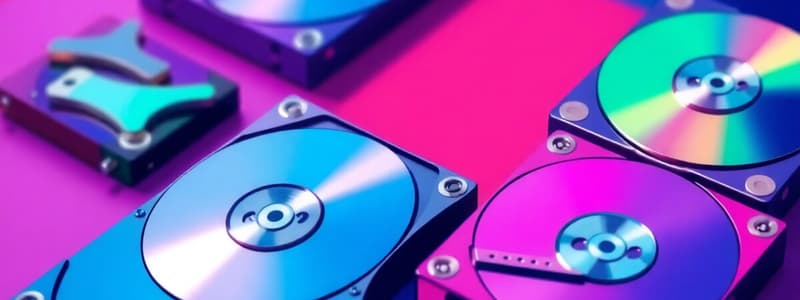Podcast
Questions and Answers
What feature allows hard drives to retain information even when powered off?
What feature allows hard drives to retain information even when powered off?
- Non-volatility (correct)
- Magnetic platters
- Mechanical components
- Random access
What is the primary function of the actuator arm within a hard drive?
What is the primary function of the actuator arm within a hard drive?
- To control the rotational speed
- To repair data
- To move back and forth to access data (correct)
- To spin the platters
What does a higher rotational speed in a hard drive improve?
What does a higher rotational speed in a hard drive improve?
- Read and write speed (correct)
- Data accuracy
- Durability of components
- Non-volatility
What is the typical rotational speed for a low-end hard drive?
What is the typical rotational speed for a low-end hard drive?
What happens to the data retrieval speed as the rotational speed of the platters increases?
What happens to the data retrieval speed as the rotational speed of the platters increases?
What is a potential disadvantage of hard drives due to their mechanical components?
What is a potential disadvantage of hard drives due to their mechanical components?
Which component specifically locates, retrieves, and writes data on the spinning platters?
Which component specifically locates, retrieves, and writes data on the spinning platters?
How does rotational latency change with an increase in platter speed?
How does rotational latency change with an increase in platter speed?
What component must be fastened to the motherboard after being slid into the M.2 interface?
What component must be fastened to the motherboard after being slid into the M.2 interface?
What is a key limitation of flash memory?
What is a key limitation of flash memory?
Which of the following is NOT a common example of flash memory?
Which of the following is NOT a common example of flash memory?
Why are flash drives not recommended for archival storage?
Why are flash drives not recommended for archival storage?
What is the main advantage of using optical drives for archival media?
What is the main advantage of using optical drives for archival media?
Which of the following types of flash memory is the smallest?
Which of the following types of flash memory is the smallest?
What technology do optical drives use to read data from discs?
What technology do optical drives use to read data from discs?
Why is it important to have backups of data stored on flash drives?
Why is it important to have backups of data stored on flash drives?
What is a significant advantage of solid-state drives (SSDs) compared to traditional hard drives?
What is a significant advantage of solid-state drives (SSDs) compared to traditional hard drives?
What does the acronym NVMe stand for?
What does the acronym NVMe stand for?
Which interface is specifically designed to work with SSDs providing higher throughput than SATA?
Which interface is specifically designed to work with SSDs providing higher throughput than SATA?
What is the primary limitation of using a SATA connection with an SSD?
What is the primary limitation of using a SATA connection with an SSD?
What physical size of drives is common in laptops?
What physical size of drives is common in laptops?
Which M.2 interface type typically provides the highest throughput?
Which M.2 interface type typically provides the highest throughput?
What does mSATA stand for?
What does mSATA stand for?
What maximum throughput capability does SATA revision 3 offer?
What maximum throughput capability does SATA revision 3 offer?
Which of the following is NOT a benefit of SSDs?
Which of the following is NOT a benefit of SSDs?
Which condition must be verified before buying an M.2-based SSD for a motherboard?
Which condition must be verified before buying an M.2-based SSD for a motherboard?
What is the main reason for the evolution from SATA to NVMe?
What is the main reason for the evolution from SATA to NVMe?
What type of storage device is commonly found as M.2 drives in newer systems?
What type of storage device is commonly found as M.2 drives in newer systems?
Why were mSATA drives developed?
Why were mSATA drives developed?
Which technology provides a more compact form factor than traditional SATA?
Which technology provides a more compact form factor than traditional SATA?
Flashcards
Hard Drive
Hard Drive
A type of storage device that uses spinning magnetic platters to store data. It retains information even when powered off.
Rotational Latency
Rotational Latency
The time it takes for the disk to rotate to the desired data location. It's shorter for faster spinning drives.
Random Access
Random Access
The ability to access any data on the drive directly without needing to go through other data first. This is different from tape drives.
Non-volatile
Non-volatile
Signup and view all the flashcards
Rotational Speed (RPM)
Rotational Speed (RPM)
Signup and view all the flashcards
Mechanical Components
Mechanical Components
Signup and view all the flashcards
Actuator Arm
Actuator Arm
Signup and view all the flashcards
Heads
Heads
Signup and view all the flashcards
Optical Drive
Optical Drive
Signup and view all the flashcards
SD card
SD card
Signup and view all the flashcards
Flash memory
Flash memory
Signup and view all the flashcards
Compact flash
Compact flash
Signup and view all the flashcards
microSD
microSD
Signup and view all the flashcards
CD-ROM
CD-ROM
Signup and view all the flashcards
DVD-ROM
DVD-ROM
Signup and view all the flashcards
Blu-ray
Blu-ray
Signup and view all the flashcards
Hard Disk Drive (HDD)
Hard Disk Drive (HDD)
Signup and view all the flashcards
Solid-State Drive (SSD)
Solid-State Drive (SSD)
Signup and view all the flashcards
Serial ATA (SATA)
Serial ATA (SATA)
Signup and view all the flashcards
Mini-SATA (mSATA)
Mini-SATA (mSATA)
Signup and view all the flashcards
M.2
M.2
Signup and view all the flashcards
Non-Volatile Memory Express (NVMe)
Non-Volatile Memory Express (NVMe)
Signup and view all the flashcards
Advanced Host Controller Interface (AHCI)
Advanced Host Controller Interface (AHCI)
Signup and view all the flashcards
B and M Key M.2 Interface
B and M Key M.2 Interface
Signup and view all the flashcards
M Key M.2 Interface
M Key M.2 Interface
Signup and view all the flashcards
B Key M.2 Interface
B Key M.2 Interface
Signup and view all the flashcards
Throughput
Throughput
Signup and view all the flashcards
Latency
Latency
Signup and view all the flashcards
Form Factor
Form Factor
Signup and view all the flashcards
PCI Express (PCIe)
PCI Express (PCIe)
Signup and view all the flashcards
Installing an M.2 Drive
Installing an M.2 Drive
Signup and view all the flashcards
Study Notes
Hard Drives
- Hard drives store information on spinning magnetic platters.
- They are non-volatile; data persists even when powered off.
- Access is random, unlike tape drives.
- Mechanical components (spinning platters, actuator arms) limit speed.
- Mechanical parts are prone to failure; hard drives are prone to failure.
- Data is stored on spinning platters; platters rotate on a spindle.
- Actuator arms control heads that move over the platters.
- Heads precisely locate, retrieve, and write data.
- Platter speed (RPM) affects data access speed.
- Common low-end speed is 5,400 RPM, resulting in 5.5ms latency.
- Faster speed (e.g., 15,000 RPM) reduces latency to 2ms.
- Multiple platters and heads allow reading/writing from multiple places.
- Common sizes: 3.5-inch, 2.5-inch, and M.2 (smaller).
- Moving away from traditional mechanical hard drives toward SSDs.
Solid-State Drives (SSDs)
- SSDs use non-volatile memory; data persists without power.
- No moving parts, reducing failure risk and improving access speeds.
- Faster performance than hard drives, with no rotational delays.
- Interfaces (e.g., SATA) are crucial for performance.
- SATA interfaces (e.g., SATA interface revision 3): throughput up to 600MB/s
- SSDs can exceed these values.
- New interface (NVMe) for high-speed SSDs.
- NVMe is designed for SSD throughput and low latency.
- Interfaces (e.g., mSATA, M.2) are used for smaller components.
M.2 Drives
- M.2 interface is a smaller form factor than SATA.
- Single connection to the motherboard; no external power needed.
- Directly connects to the PCI Express bus for high throughput.
- 4 Gb/s throughput is possible with a 4 PCIe lane interface.
- Different key types (B key, M key) for compatibility and interface design in M.2 connectors.
- Verification of motherboard components' support for NVMe and M.2 key types is needed.
- Simple installation: the SSD is inserted into the M.2 slot on the motherboard and fastened with a screw.
Flash Memory
- Flash memory (EEPROM) is another non-volatile storage type.
- Limited write cycles (read-only after reaching a threshold).
- Not suitable for large-scale data archiving due to write limitations.
- Common examples include USB flash drives, SD cards, microSD cards.
Optical Drives
- Optical drives use lasers to read data on optical media (CD-ROMs, DVDs, Blu-rays).
- Suitable for archival storage.
- Optical drives are less common in modern systems.
Studying That Suits You
Use AI to generate personalized quizzes and flashcards to suit your learning preferences.




